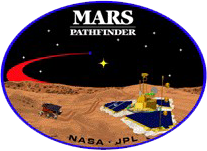
July 04, 1997 - September 27, 1997-83 sols (Martian Year 23,142.3-Ls-188.0)
Mission Description
The mission utilized an air bag landing system and innovative petal design. The rover, planned for 7 days, lasted for 83 sols, acquiring imaging and chemical and meteorological measurements. The mission consisted of a lander (Carl Sagan Memorial Stadium) that carried a camera (Imaging for Mars Pathfinder - IMP) and a weather station (Atmospheric Structure Instrument/Meteorology Package - ASI/MET) and the rover (Sojourner rover - with an Alpha/Proton/X-ray Spectrometer (APXS) and camera.
Scientific Objectives
The Mars Pathfinder mission provided a third set of in-situ measurements of the Martian atmosphere, after the two Viking Landers. The ASI/MET package was designed to collect density, temperature and pressure information about the structure of the Martian atmosphere during the spacecraft's passage through the atmosphere, from about 150 km altitude down to the surface. On the surface, it monitored the temperature, pressure and wind speed and direction at the landing site for the duration of the mission. Combined with information collected from the Imager about atmospheric aerosols and dust, the amount of water vapor at the landing site, and wind information derived from observation of the MET mast-mounted wind socks, these data provide self-consistent atmospheric information and temporal variation. For more information see the following links:
The atmospheric data complement
The mission utilized an air bag landing system and innovative petal design. The rover, planned for 7 days, lasted for 83 sols, acquiring imaging and chemical and meteorological measurements. The mission consisted of a lander (Carl Sagan Memorial Stadium) that carried a camera (Imaging for Mars Pathfinder - IMP) and a weather station (Atmospheric Structure Instrument/Meteorology Package - ASI/MET) and the rover (Sojourner rover - with an Alpha/Proton/X-ray Spectrometer (APXS) and camera.
Scientific Objectives
The Mars Pathfinder mission provided a third set of in-situ measurements of the Martian atmosphere, after the two Viking Landers. The ASI/MET package was designed to collect density, temperature and pressure information about the structure of the Martian atmosphere during the spacecraft's passage through the atmosphere, from about 150 km altitude down to the surface. On the surface, it monitored the temperature, pressure and wind speed and direction at the landing site for the duration of the mission. Combined with information collected from the Imager about atmospheric aerosols and dust, the amount of water vapor at the landing site, and wind information derived from observation of the MET mast-mounted wind socks, these data provide self-consistent atmospheric information and temporal variation. For more information see the following links:
The atmospheric data complement
Lander Atmospheric Entry Profile (Density, pressure, temperature, versus altitude)
Point-by-point Surface meteorology data (pressure, temperature, wind sensor signals), sols 1-83
Atmospheric opacity derived from IMP imaging of the solar disk, sols 1-83 (in PDS??)
Individual wind speed estimates derived from IMP images of MPF's Windsock, sols 1-83
Dust devils from IMP images
Point-by-point Surface meteorology data (pressure, temperature, wind sensor signals), sols 1-83
Atmospheric opacity derived from IMP imaging of the solar disk, sols 1-83 (in PDS??)
Individual wind speed estimates derived from IMP images of MPF's Windsock, sols 1-83
Dust devils from IMP images
 PDS: The Planetary Atmospheres Node
PDS: The Planetary Atmospheres Node


